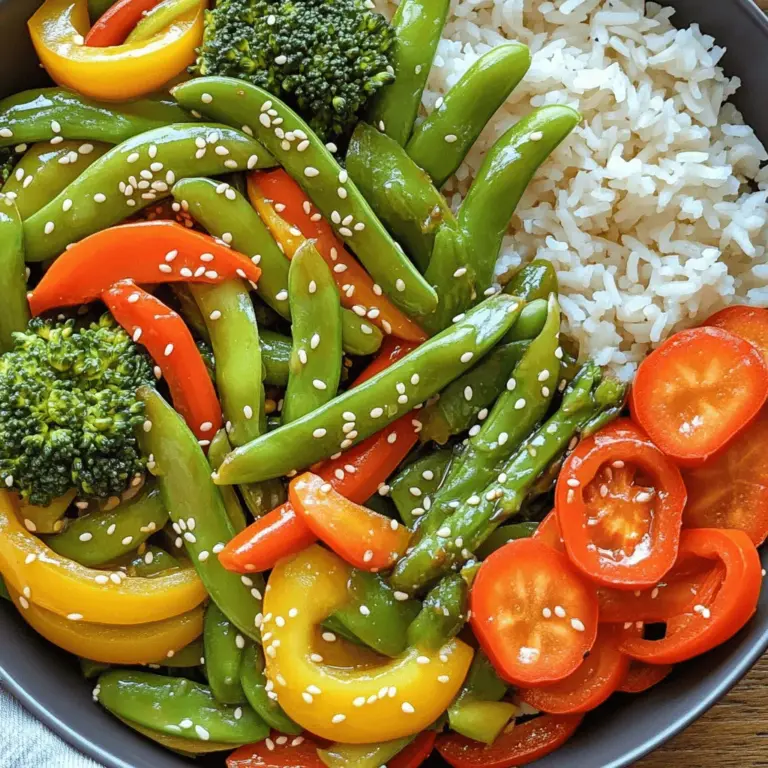Spring is here, and it’s the perfect time to enjoy fresh, vibrant flavors! A Spring Vegetable Stir-Fry brings seasonal produce like snap peas, asparagus, and bell peppers together in a quick, satisfying meal. In this blog, I’ll share the essential ingredients, simple steps, and tips to make a delicious dish that’ll impress your family or friends. Let’s jump in and create a colorful stir-fry that’s as tasty as it is healthy!
Ingredients
Seasonal Vegetables to Include
For a vibrant spring vegetable stir-fry, I love to use these fresh options:
- 1 cup snap peas, trimmed
- 1 cup asparagus, chopped into 2-inch pieces
- 1 cup bell peppers (mixed colors), sliced
- 1 cup baby carrots, halved
- 1 cup broccoli florets
- 1 cup shiitake mushrooms, sliced
These vegetables add color, crunch, and nutrients. You can also try adding zucchini or radishes for extra flavor and texture.
Essential Cooking Oils and Seasonings
To bring flavor to your stir-fry, choose these essential ingredients:
- 2 tablespoons vegetable oil
- 3 tablespoons soy sauce (or tamari for gluten-free)
- 1 tablespoon sesame oil
For an aromatic base, don’t forget to add:
- 2 cloves garlic, minced
- 1 inch piece of ginger, grated
The garlic and ginger give a warm and fragrant flavor that makes your stir-fry shine.
Garnishes and Accompaniments
Garnishes elevate the dish. Consider these for a perfect finish:
- 1 tablespoon sesame seeds (for garnish)
- Chopped green onions
For side dishes, I recommend serving with jasmine rice or quinoa. They complement the stir-fry well and make it a complete meal.
Step-by-Step Instructions
Preparation of Ingredients
Start by washing all your vegetables. Make sure they are clean and fresh. Next, cut them into bite-sized pieces. This helps them cook evenly. For example, chop the asparagus into 2-inch pieces. Slice the bell peppers thinly. Halve the baby carrots, and keep the snap peas whole.
To stay organized, gather your tools first. Have a cutting board and a sharp knife ready. Use bowls to hold your chopped veggies. This keeps your workspace neat and makes cooking easy.
Cooking Method
Heat 2 tablespoons of vegetable oil in a large wok or a non-stick skillet. Turn the heat to medium-high. When the oil is hot, add 2 cloves of minced garlic and 1 inch of grated ginger. Stir-fry these for about 30 seconds. You want to release their great smell.
Now, it’s time to add the snap peas and asparagus. Stir-fry them for 2-3 minutes. This gives them a nice crunch. Next, toss in the bell peppers and baby carrots. Stir everything for about 3 minutes until they soften. Finally, add the broccoli florets and shiitake mushrooms. Cook for another 2 minutes. You want all your veggies to look bright and colorful.
Final Seasoning and Serving
Seasoning is key to great flavor. Pour in 3 tablespoons of soy sauce and 1 tablespoon of sesame oil. Toss the veggies well, ensuring they are coated. Taste and add salt and pepper as needed.
To serve, transfer the stir-fry to a deep bowl. Sprinkle it with sesame seeds for a nice finish. For a complete meal, pair it with jasmine rice or quinoa. This dish looks vibrant and tastes amazing.
Tips & Tricks
Achieving Perfect Vegetable Texture
To get the best texture, timing is key. Start with snap peas and asparagus. These need about 2-3 minutes to soften. Next, add bell peppers and baby carrots. Stir-fry them for 3 minutes. Finally, add broccoli and shiitake mushrooms. They only need 2 more minutes. Take the stir-fry off the heat as soon as the veggies are bright and crisp. Overcooking can make them mushy.
Enhancing Flavor Profiles
To boost flavor, think about adding sauce or spices. You can try a splash of chili sauce for heat. Fresh herbs like basil or cilantro add brightness. Just add them at the end to keep them fresh. You might also consider a splash of rice vinegar or a squeeze of lime for a zesty kick. The more layers of flavor, the better your dish will taste.
Cooking Tools for Best Results
Choosing the right tools makes cooking easier. A large, flat-bottomed wok or a non-stick skillet works best. These let the heat spread evenly. Good tools help you stir-fry quickly, keeping the veggies crisp. Use a spatula to toss the ingredients. A good knife for cutting saves time and effort. You might also want a cutting board that gives you space to prep efficiently.

Variations
Different Protein Additions
You can add protein to your stir-fry for extra flavor and nutrition. Good choices include:
- Tofu
- Chicken
- Shrimp
- Beef
If you use chicken or beef, cut them into small pieces. Cook these proteins before adding vegetables. Chicken takes about 5-7 minutes to cook. Beef needs about the same time. Shrimp cooks quickly, just 2-3 minutes. Tofu should be golden brown before you add veggies.
Vegan and Gluten-Free Options
Making this dish vegan or gluten-free is easy. For vegan options, use tofu or tempeh instead of meat. You can also swap soy sauce for tamari to keep it gluten-free. Other great substitutes include:
- Coconut aminos
- Miso paste
For added flavor, use plant-based sauces like hoisin or peanut sauce. These can boost taste while keeping it vegan.
Global Inspirations
You can draw inspiration from many cuisines. For a Thai twist, add basil and lime juice. For a Chinese flair, use five-spice powder and chili oil. Possible spices and condiments include:
- Curry powder
- Sriracha
- Lemon grass
Feel free to mix and match these flavors. It makes the dish unique and exciting.
Storage Info
Best Practices for Storing Leftovers
After you enjoy your spring vegetable stir-fry, it’s key to store leftovers right. Start by letting the dish cool down. This will keep moisture from building up. Once cool, place the stir-fry in airtight containers. Glass containers work best, as they don’t absorb smells. You can also use plastic containers, just ensure they are food-safe.
Reheating Techniques
When it’s time to reheat, aim for methods that keep the veggies crisp. The microwave is quick, but it can make the stir-fry soggy. Instead, use a skillet on low heat. Add a splash of water or broth to help steam it gently. Stir often to avoid burning. This way, you keep that fresh taste and texture.
Freezing Guidelines
Yes, you can freeze stir-fry! To do this, let it cool and then transfer it to freezer-safe bags. Squeeze out the air before sealing. You can freeze it for up to three months. However, be aware that some veggies may lose their crunch after thawing. The taste will still be good, but the texture may change. For the best results, enjoy your stir-fry fresh!
FAQs
What vegetables are best for stir-fry?
For stir-fry, fresh and crisp vegetables work best. I love using snap peas, asparagus, and bell peppers. These add bright colors and flavors. Baby carrots, broccoli, and shiitake mushrooms also shine in this dish. You can mix and match based on what’s in season. Spring brings a bounty of choices that add great taste and nutrition.
Can I use frozen vegetables for this recipe?
Yes, you can use frozen vegetables. They are convenient and save time. Frozen veggies often come pre-cut and ready to use. However, they may not taste as fresh as the seasonal ones. Frozen vegetables can lose some texture when cooked. If you go this route, cook them for a shorter time. This helps keep them crisp and colorful.
How to adjust this recipe for a larger crowd?
To serve more people, double the ingredients. Use two cups of each vegetable. If you want to keep the stir-fry balanced, add more sauce. Remember to increase the cooking time slightly. Stir-fry in batches if your pan is small. This keeps the heat high and ensures everything cooks evenly.
What can I serve with spring vegetable stir-fry?
Serving suggestions can elevate your meal. Jasmine rice or quinoa pairs beautifully with the stir-fry. You can also serve it with noodles for a filling dish. For added protein, consider grilled chicken or tofu. This makes a complete meal that is not only tasty but filling. Explore different combinations to find your favorite!
In this article, we explored how to make a vibrant spring vegetable stir-fry. We discussed the best seasonal veggies to use, key oils and spices, and simple preparation steps. You learned how to achieve the best textures and flavor profiles while also adapting for different diets. Remember, stir-frying is versatile and fun. With these tips, you can create a delicious meal that suits your taste. Enjoy experimenting with flavors and sharing your dish with others. Happy cooking!


